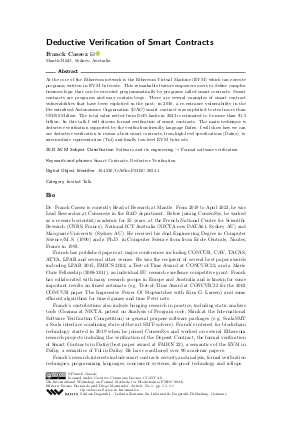Deductive Verification of Smart Contracts (Invited Talk)
Author
Franck Cassez 
-
Part of:
Volume:
5th International Workshop on Formal Methods for Blockchains (FMBC 2024)
Part of: Series: Open Access Series in Informatics (OASIcs)
Part of: Conference: Workshop on Formal Methods for Blockchains (FMBC) - License:
 Creative Commons Attribution 4.0 International license
Creative Commons Attribution 4.0 International license
- Publication Date: 2024-05-21
File

PDF
OASIcs.FMBC.2024.1.pdf
- Filesize: 292 kB
- 1 pages
Document Identifiers
Subject Classification
ACM Subject Classification
- Software and its engineering → Formal software verification
Keywords
- Smart Contracts
- Deductive Verification
Metrics
- Access Statistics
-
Total Accesses (updated on a weekly basis)
0PDF Downloads0Metadata Views
Abstract
At the core of the Ethereum network is the Ethereum Virtual Machine (EVM) which can execute programs written in EVM bytecode. This remarkable feature empowers users to define complex business logic that can be executed programmatically by programs called smart contracts. Smart contracts are programs and may contain bugs. There are several examples of smart contract vulnerabilities that have been exploited in the past: in 2016, a re-entrance vulnerability in the Decentralised Autonomous Organisation (DAO) smart contract was exploited to steal more than USD50 Million. The total value netted from DeFi hacks in 2023 is estimated to be more than $1.5 billion. In this talk I will discuss formal verification of smart contracts. The main technique is deductive verification supported by the verification-friendly language Dafny. I will show how we can use deductive verification to reason about smart contracts, from high-level specifications (Dafny), to intermediate representation (Yul) and finally low-level EVM bytecode.
Cite As Get BibTex
Franck Cassez. Deductive Verification of Smart Contracts (Invited Talk). In 5th International Workshop on Formal Methods for Blockchains (FMBC 2024). Open Access Series in Informatics (OASIcs), Volume 118, p. 1:1, Schloss Dagstuhl – Leibniz-Zentrum für Informatik (2024)
https://doi.org/10.4230/OASIcs.FMBC.2024.1
BibTex
@InProceedings{cassez:OASIcs.FMBC.2024.1,
author = {Cassez, Franck},
title = {{Deductive Verification of Smart Contracts}},
booktitle = {5th International Workshop on Formal Methods for Blockchains (FMBC 2024)},
pages = {1:1--1:1},
series = {Open Access Series in Informatics (OASIcs)},
ISBN = {978-3-95977-317-1},
ISSN = {2190-6807},
year = {2024},
volume = {118},
editor = {Bernardo, Bruno and Marmsoler, Diego},
publisher = {Schloss Dagstuhl -- Leibniz-Zentrum f{\"u}r Informatik},
address = {Dagstuhl, Germany},
URL = {https://drops.dagstuhl.de/entities/document/10.4230/OASIcs.FMBC.2024.1},
URN = {urn:nbn:de:0030-drops-198664},
doi = {10.4230/OASIcs.FMBC.2024.1},
annote = {Keywords: Smart Contracts, Deductive Verification}
}
